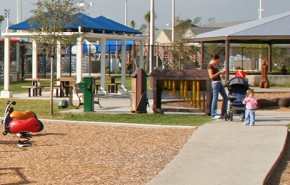The 2019 Pennsylvania Recreation and Park Society (PRPS) conference brought together more than 400 attendees to share knowledge on a range of parks planning topics. GAI Director of Park System Planning Kristin Caborn, CPRE, FCP was among the presenters, offering a detailed discussion of Crime Prevention Through Environmental Design (CPTED) at the gathering that took place in State College, PA. We spoke to Kristin about the event, CPTED, and her role as a presenter.
Q: Can you tell us about the PRPS conference?
Kristin: The Pennsylvania Recreation and Park Society annual conference is an event in which parks and recreation professionals from around the state of Pennsylvania—cities, townships, boroughs, and counties—come together to network and learn about various topics that are relevant in parks and recreation currently. This is the second year that GAI has been involved in the event.
Q: What’s special about the PRPS conference and what does the event offer attendees?
Kristin: It’s a gathering of like-minded professionals, and the networking at this conference is a huge opportunity for public employees to not only meet each other, but to become acquainted with a range of planning and engineering professionals as well.
People in government parks and recreation departments can talk with landscape architects, planners, and engineers–these exchanges are very valuable for defining needed innovations and setting the stage for developing ongoing best practices.
Q: You led a presentation called ‘CPTED and Parks Planning.’ Can you tell us what CPTED stands for and the goal of your presentation?
Kristin: CPTED stands for Crime Prevention Through Environmental Design. The idea of CPTED is that the proper design of a built environment can help to deter crime. I have been a certified CPTED practitioner in the state of Florida since 2006—which is the ‘FCP’ designation after my name.
We apply CPTED in our parks planning work at GAI, and I’m sharing the concept with the local government parks and recreation audience so they can consider it in their work. My goal is to give the parks and recreation professionals the tools they need to communicate about CPTED concepts with the professionals they may work with like landscape architects, engineers, planners, and others.
Kristin’s basic CPTED takeaways:
- CPTED strategies in the design of built environments can lead to reductions in the incidence of crime
- Benefits to parks include increased patronage, greater community safety and satisfaction, and reduced maintenance costs
- CPTED in parks planning involves the community in order to assess perceived crime and safety risks
Some CPTED parks planning strategies include:
- Emphasis on ‘natural surveillance’ with designs that allow clear, unobstructed views
- Concentrated activity areas that encourage multiple normal park users to gather in designated areas for increased periods of time
- Well-defined, well-lit, easily visualized park entry/exit points
- Clear signage that promotes easy wayfinding
- Quick removal of graffiti to help normal park users feel more welcome
- Regular trimming of trees and vegetation that may obscure park lighting
- Providing water, shade, and seating to encourage the extended presence of normal park users
- Engagement of park maintenance staff for early identification of potential issues
Q: You mentioned earlier that CPTED concepts are applied to your parks planning work at GAI—can you tell us a little more about that?
Kristin: At GAI, when we create parks and recreation system master plans and we inventory parks for clients, we always do so with an eye toward CPTED. We have given CPTED overviews to all staff who are involved with parks planning projects so they can quickly spot issues, bring them up to our clients, and help them to rectify the situations they’ve identified. Then, as we proceed through the park site master planning process, we can design sites with an eye toward CPTED—keeping appropriate separations, designing landscaping that is appropriate for natural surveillance, etc.—and that’s something that most other firms are not necessarily equipped to do because they often don’t have a CPTED practitioner on staff.
![]()
Q: In addition to our CPTED focus, what value do you feel GAI brings to parks planning projects?
Kristin: GAI’s Community Solutions Group (CSG) includes planners, designers, and landscape architects, and more—some who have been working on parks projects for more than 50 years. With that experience, if a client has a question about design or even construction, we can quickly address almost any concern. Our value is based on the fact that we have the knowledge, the experience, the focus, and the integrated, multidisciplined staff to handle a broad range of parks planning considerations right in house.
With experience in both the public and private side of parks planning, we are very focused on our local government clients and take great pride in our continuing services agreements with all of the parks and rec departments we work with. Our experience enables us to accurately gauge project impacts from the public-side perspective, keeping in mind the ever-present need to turn out projects on time, within budget, and designed so they can be easily maintained. Our CPTED focus helps ensure that our designs present safe environments for the people who will enjoy them, and that I feel is a real differentiator for us.
Read Kristin’s previous article detailing CPTED for parks planning.
Contact Kristin Caborn, 321.319.3161, for more information about CPTED and GAI’s parks planning services.
![]() GAI Director of Park System Planning Kristin Caborn, CPRE, FCP is a certified CPTED practitioner with extensive parks and recreation management and planning experience. She has managed several multimillion-dollar parks and recreation projects and provided master plan implementation and phasing plans services for public-sector clients.
GAI Director of Park System Planning Kristin Caborn, CPRE, FCP is a certified CPTED practitioner with extensive parks and recreation management and planning experience. She has managed several multimillion-dollar parks and recreation projects and provided master plan implementation and phasing plans services for public-sector clients.


